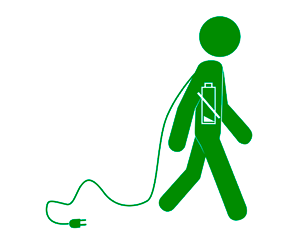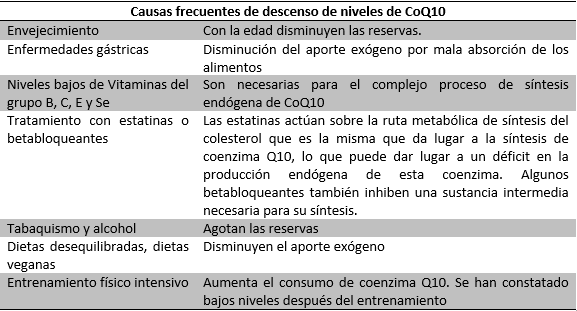Coenzyme Q10 is a molecule naturally present in mitochondria and in the nucleus of cells and is especially abundant in the tissue of vital organs such as the heart, liver, kidneys and pancreas, as well as in blood plasma associated with lipoproteins that transport cholesterol.
In the human body, it is synthesized in the liver and can also be obtained through food, although the dietary intake is very low, because it is found in small quantities in the foods that are part of our usual diet and the foods with the highest content, such as the heart and liver of pigs and cattle, are low-consumption foods.

This coenzyme has two essential functions: energy production and the antioxidant effect. On the one hand, it is essential for energy production processes since, in cells, it is involved in the transport of electrons and in aerobic cellular respiration, participating in the production of adenosine triphosphate (ATP), which is a fundamental nucleotide in obtaining cellular energy. It also acts as an antioxidant in the body, due to its chemical structure and its ability to accept or give up electrons. In other words, the main functions of coenzyme Q10 are to convert energy from carbohydrates and lipids into usable energy, and to protect cells, tissues and organs from the oxidative and damaging action of free radicals that are involved in aging processes and in the development of health problems such as heart disease and
cancer.
In the human body, it comes in three forms depending on its oxide/reduction state. The oxidized form is called ubiquinone (Q), the reduced form ubiquinol (QH2) and there is an intermediate oxide-reduction state in which the molecule is called ubisemiquinone
(Q).
The reduced form (ubiquinol) plays an antioxidant role in different tissues, protecting cell membranes from lipid oxidation.
Several factors can cause a drop in coenzyme Q10 levels that will influence energy production processes and multiple functions of the body. The content of coenzyme Q10 decreases in the human body in the natural aging process. With age, its production and the ability to convert the Q10 coenzyme to the form of ubiquinol decreases, which is how the form that the body uses to perform its antioxidant function has been mentioned. It is estimated that after the age of 20 it decreases to a reduction of 65% at the age of 80. But in addition, there are also other causes for which the amount of coenzyme Q10 in the body may decrease, either because they increase consumption or because they cause its production to decrease. Among these causes, the main ones are: stress, certain chronic diseases, some medications such as statins to lower cholesterol or beta-blockers widely used in different disorders affecting heart function (such as hypertension, arrhythmia, etc.). In addition, exercise or physical overexertion consume energy and therefore increase the requirement
for CoQ10.

Due to the two main actions mentioned (energy and antioxidant) and based on multiple studies, coenzyme Q 10 supplementation is proposed as a measure for the maintenance of different physiological functions, related to cardiovascular health, low energy states (asthenia, tiredness, fatigue), for recovery from intense physical exercise or sports training and to prevent and recover damage caused by solar radiation and different environmental factors to the skin.
Cardiovascular health.  Research suggests that the beneficial effect of coenzyme Q10 in preventing cardiovascular diseases is mainly due to its ability to inhibit the oxidation of LDL cholesterol (“bad cholesterol”) molecules, which is one of the causes of atheromatous plaque formation in blood vessels, a leading cause of serious cardiovascular problems. It has been found that levels of coenzyme Q10 tend to be lower in people with high cholesterol, compared to healthy people of the same age
Research suggests that the beneficial effect of coenzyme Q10 in preventing cardiovascular diseases is mainly due to its ability to inhibit the oxidation of LDL cholesterol (“bad cholesterol”) molecules, which is one of the causes of atheromatous plaque formation in blood vessels, a leading cause of serious cardiovascular problems. It has been found that levels of coenzyme Q10 tend to be lower in people with high cholesterol, compared to healthy people of the same age
.
On the other hand, as mentioned above, it has been observed that statins and some beta-blocker drugs can lower natural levels of coenzyme Q10 in the body and that supplementation with coenzyme Q10 could be beneficial for patients who take these medications both at the cardiovascular level and to help them conserve energy without affecting the effectiveness of the drugs. There is also evidence that the CoQ-10 supplement, together with conventional medical treatment, may provide certain benefits on high blood pressure, which has been proven
in several clinical studies.
It helps recovery in sports training and a source of energy against fatigue. The practice of exercise causes an overload of work on the heart and muscles, which are the organs that consume the most energy, and this also causes the release of free radicals that are produced in the process of obtaining the energy necessary to carry out these tasks. This increase in free radicals causes oxidation reactions that can end up damaging cells and causing muscle overload and fatigue, with reduced physical performance
.
Fatigue is the manifestation of energy depletion. Different investigations have proven that oral administration of ubiquinol, the reduced form of coenzyme Q10, improves physical performance and the subjective feeling of fatigue during exercise, increasing tolerance to effort and sports performance, especially in sports such as cycling, running or athletics, which involve a great
expenditure of energy.
Skin support (anti-aging effect).  Aging and photoaging processes are associated with increased cellular oxidation. In part, it may be due to a decrease in coenzyme Q10 levels. Dietary supplementation of this coenzyme has been considered an effective way to maintain the level, which decreases both with age and under certain pathological conditions. CoQ10 plays an important role in the skin due to its bioenergetic and antioxidant properties and this effect could be related to the CoQ10 content of the skin itself, especially in the
Aging and photoaging processes are associated with increased cellular oxidation. In part, it may be due to a decrease in coenzyme Q10 levels. Dietary supplementation of this coenzyme has been considered an effective way to maintain the level, which decreases both with age and under certain pathological conditions. CoQ10 plays an important role in the skin due to its bioenergetic and antioxidant properties and this effect could be related to the CoQ10 content of the skin itself, especially in the
epidermis.
Some studies have shown that prolonged intake of CoQ10 for at least two weeks can reduce wrinkles and provide other benefits related to the powerful antioxidant and energizing effect on the skin and improving the protection that the epidermis offers against the action of ultraviolet rays.
Safety. Coenzyme Q10 supplementation, especially in the form of ubiquinol, is considered safe and very well tolerated, although analytical and medical monitoring is recommended in people undergoing treatment and its use in pregnancy and breastfeeding is not recommended due to lack of data. The European Food Safety Agency (AESAN) considers the consumption of up to 200 mg daily to be acceptable from a safety point of view when used as a supplement
.
AECOSAN. Journal of the AESAN Scientific Committee. No. 17 (2013).
Report of the Scientific Committee of the Spanish Agency for Food Safety and Nutrition (AESAN) on conditions of use of certain substances other than vitamins, minerals and plants to be used in food supplements. Page 128-135
Artuch R. et al. Ubiquinone: metabolism and functions. Ubiquinone deficiency and its implication in mitochondrial encephalomyopathies. Ubiquinone treatment.1999. Journal of Neurology 29 (1)
:59-63
Ashida Y, Kuwazuru S, Nakashima M and Watabe K, Effect of CoQ10 as a supplement on wrinkle reduction, Food Style 21. 8 (6) (2004), 52—54.
Ashida Y1, Yamanishi H, Terada T, Oota N, Sekine K, Watabe K. CoQ10 supplementation elevates the epidermal CoQ10 level in adult hairless mice. Biofactors. 2005; 25 (1-4) :175-8
.
Bhagavan, H.N. and Chopra, R.K. (2006). Coenzyme Q10: absorption, tissue uptake, metabolism and pharmacokinetics. Free Radical Research, 40 (5), pp: 445-453
.
Bhagavan, H.N. and Chopra, R.K. (2007). Plasma coenzyme Q10 response to oral ingestion of coenzyme Q10 formulations. Mitochondrion, 7, pp:
S78-88.
Cooke M, Iosia M, Buford T, Shelmadine, Hudson G et al. J Int Soc Sports Nutr. 2008 Mar 4; 5:8. doi: 10.1186/1550-2783-5-8. Effects of acute and 14-day coenzyme Q10 supplementation on exercise performance in both trained and untrained individuals
.
Crane, F.L. (2001). Biochemical functions of coenzyme Q10. Journal of the American College of Nutrition, 20 (6), pp: 591-598
.
Hoppe U, Bergemann J, Steckel F, et al., Coenzyme Q10, a cutaneous antioxidant and energizer, BioFactors 9 (1999), 371—378
Iwamoto G, Yamagami T, Folkers K, Blomqvist C.G. Deficiency of coenzyme Q10 in hypertensive rats and reduction of deficiency by treatment with coenzyme Q10. Biochem Biophys Res Commun. 1974 Jun 4; 58
(3) :743-8.
Passi S, De Pita O, Littarru GP et al., The combined use of oral and topical lipophilic antioxidants increases their levels both in sebum and stratum corneum, BioFactors 18 (2003), 289-297.
Pepe S, Marasco SF, Haas SJ, Sheeran FL, Krum H, Rosenfeldt FL. Coenzyme Q10 in cardiovascular disease. Mitochondrion. 2007 June 7; Suppl:S154-67. Epub 2007 Mar 16.
Rosenfeldt FL, Haas SJ, Krum H, Hadj A, Ng K, Leong JY, Watts GF. Coenzyme Q10 in the treatment of hypertension: a meta-analysis of the clinical trials. J Hum Hypertens. 2007 Apr.; 21 (4) :297-306. Epub 2007 Feb 8.
Nutrition treaty. Physiological and biochemical bases of nutrition. Angel Gil Hernandez. Editorial MĂ©dica Panamericana. 3rd Edition
. 2017
Yamagami T, Shibata N, Folkers K. Bioenergetics in clinical medicine. Studies on coenzyme Q10 and essential hypertension. Res Commun Chem Pathol Pharmacol. 1975 Jun; 11
(2) :273-88.
Young JM1, Florkowski CM, Molyneux SL, McEwan RG, Frampton CM, Nicholls MG, Scott RS, George PM. A randomized, double-blind, placebo-controlled crossover study of coenzyme Q10 therapy in hypertensive patients with the metabolic syndrome. Am J Hypertens. 2012 Feb; 25 (2) :261-70. doi:10.1038/ajh.2011.209
.
Professor Mª José Alonso Osorio

- Graduated in Pharmacy from the University of Barcelona.
- Graduated in Phytotherapy from the University of Montpellier.
- Specialist in Galenic and Industrial Pharmacy.
- Technical Director and responsible for product development in the Pharmaceutical Industry (1972 to 1985).
- Community pharmacist (from 1985 to 2004 as owner and co-owner, since 2010 as a part-time substitute).
- Professor and tutor in Master and Postgraduate Phytotherapy UB - IL3 (University of Barcelona)
- Collaborating professor in the Masters Degree in Nutrition and Health, UOC (Open University of Catalonia)
- Member of the Governing Board of the Spanish Phytotherapy Society.
- Member of the Scientific Committee of INFITO (Center for Research on Phytotherapy).
- Member of the AEEM (Spanish Association for the Study of Menopause)
- Corresponding academic of the Royal Academy of Pharmacy of Catalonia.
All rights reserved ©. The reproduction, partial or total, of the content in any form is prohibited without the prior written consent of Cien Por Cien Natural SL. If you want to share the information, reproduction is allowed by citing Cien Por Cien Natural SL or using the link on their website. Cien Por Cien Natural SL is not responsible for misuse of the content of the article
.






